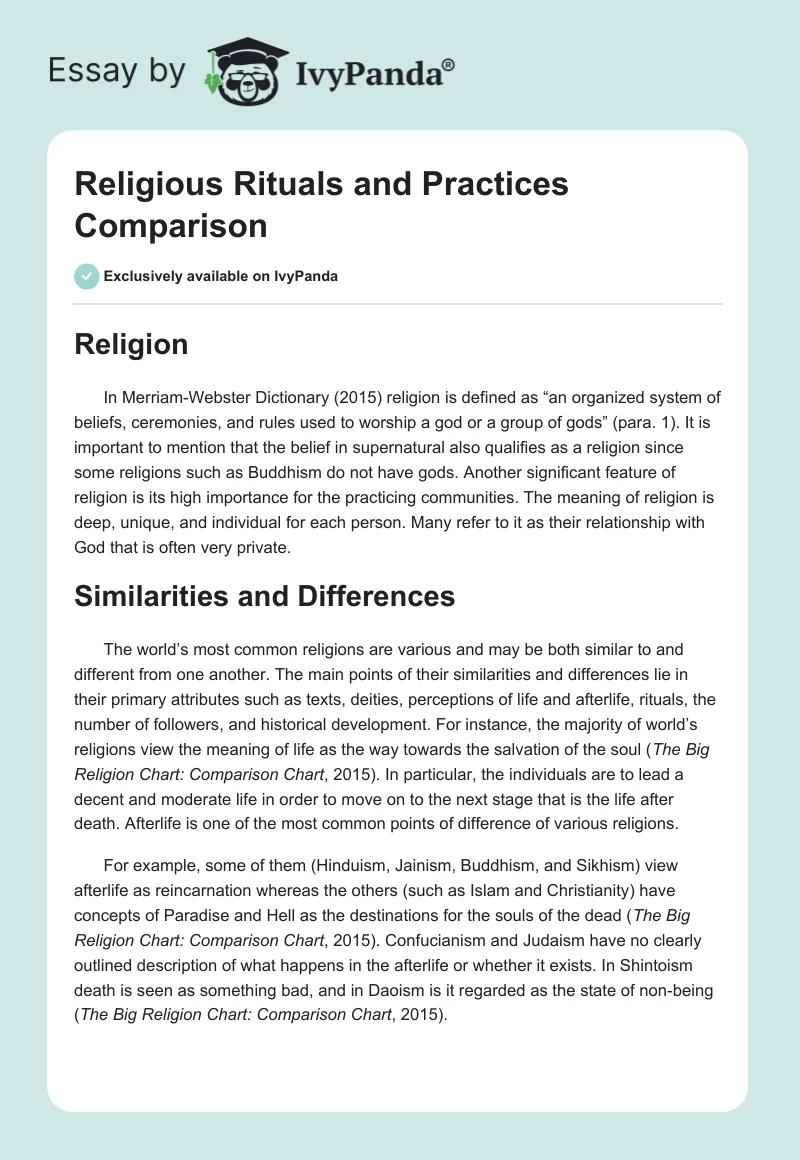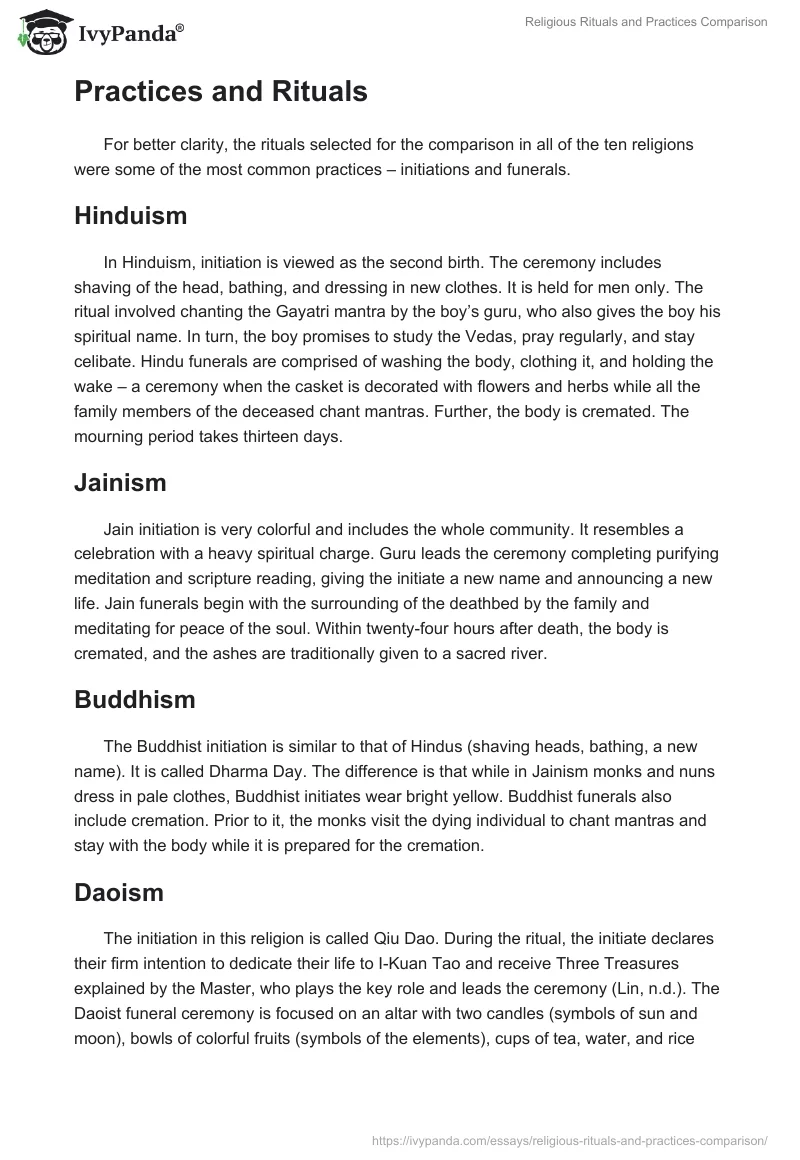Religion
In Merriam-Webster Dictionary (2015) religion is defined as “an organized system of beliefs, ceremonies, and rules used to worship a god or a group of gods” (para. 1). It is important to mention that the belief in supernatural also qualifies as a religion since some religions such as Buddhism do not have gods. Another significant feature of religion is its high importance for the practicing communities. The meaning of religion is deep, unique, and individual for each person. Many refer to it as their relationship with God that is often very private.
Similarities and Differences
The world’s most common religions are various and may be both similar to and different from one another. The main points of their similarities and differences lie in their primary attributes such as texts, deities, perceptions of life and afterlife, rituals, the number of followers, and historical development. For instance, the majority of world’s religions view the meaning of life as the way towards the salvation of the soul (The Big Religion Chart: Comparison Chart, 2015). In particular, the individuals are to lead a decent and moderate life in order to move on to the next stage that is the life after death. Afterlife is one of the most common points of difference of various religions.
For example, some of them (Hinduism, Jainism, Buddhism, and Sikhism) view afterlife as reincarnation whereas the others (such as Islam and Christianity) have concepts of Paradise and Hell as the destinations for the souls of the dead (The Big Religion Chart: Comparison Chart, 2015). Confucianism and Judaism have no clearly outlined description of what happens in the afterlife or whether it exists. In Shintoism death is seen as something bad, and in Daoism is it regarded as the state of non-being (The Big Religion Chart: Comparison Chart, 2015).
Practices and Rituals
For better clarity, the rituals selected for the comparison in all of the ten religions were some of the most common practices – initiations and funerals.
Hinduism
In Hinduism, initiation is viewed as the second birth. The ceremony includes shaving of the head, bathing, and dressing in new clothes. It is held for men only. The ritual involved chanting the Gayatri mantra by the boy’s guru, who also gives the boy his spiritual name. In turn, the boy promises to study the Vedas, pray regularly, and stay celibate. Hindu funerals are comprised of washing the body, clothing it, and holding the wake – a ceremony when the casket is decorated with flowers and herbs while all the family members of the deceased chant mantras. Further, the body is cremated. The mourning period takes thirteen days.
Jainism
Jain initiation is very colorful and includes the whole community. It resembles a celebration with a heavy spiritual charge. Guru leads the ceremony completing purifying meditation and scripture reading, giving the initiate a new name and announcing a new life. Jain funerals begin with the surrounding of the deathbed by the family and meditating for peace of the soul. Within twenty-four hours after death, the body is cremated, and the ashes are traditionally given to a sacred river.
Buddhism
The Buddhist initiation is similar to that of Hindus (shaving heads, bathing, a new name). It is called Dharma Day. The difference is that while in Jainism monks and nuns dress in pale clothes, Buddhist initiates wear bright yellow. Buddhist funerals also include cremation. Prior to it, the monks visit the dying individual to chant mantras and stay with the body while it is prepared for the cremation.
Daoism
The initiation in this religion is called Qiu Dao. During the ritual, the initiate declares their firm intention to dedicate their life to I-Kuan Tao and receive Three Treasures explained by the Master, who plays the key role and leads the ceremony (Lin, n.d.). The Daoist funeral ceremony is focused on an altar with two candles (symbols of sun and moon), bowls of colorful fruits (symbols of the elements), cups of tea, water, and rice (symbols of yin, yang, and their unity). Such altars are maintained for several days or a week after which the body is buried.
Confucianism
In this religion, the practice of initiation was not created as no specific ceremonies were required to convert an individual into it. As for the funerals, Confucianism is based on the honor of the ancestors, and that is why the funeral rituals and memory of the dead were to be carefully followed not to upset the spirits of the ancestors.
Shinto
The initiation in Shinto is called Shichi-go-san which can be translated as 7-5-3. The children of 7, 5, and 3, along with their parents participate in a festive ceremony that symbolizes health and long life. Shinto funeral ceremonies are planned very carefully with as many as twenty different rituals. Such ceremonies are rather costly. The deceased persons are first cremated and then the ashes may be buried as well.
Judaism
Jewish initiation includes two stages for boys (circumcision and Bar Mitzvah) and one for girls (Bat Mitzvah). The latter is a more recent tradition. Boys’ initiation is held in a Synagogue on the first Saturday after they turn thirteen; the girls have their initiation at the age of twelve (Klug, 2016). Both rituals symbolize the commitment the adolescents make to their religion and their adulthood. Jewish funerals are rather simple and short. The closest relatives of the deceased are to tear their clothes as a symbol of loss and read blessings. While the casket is carried, the procession stops seven times to read Psalm 91.
Sikhism
The initiation is held in front of five initiated community members. The ceremony begins with the singing of hymns and moves on to the preparation of amrit – a mix of water and sugar stirred with a sword (Amrit ceremony, 2009). The initiates are to drink the solution and have it sprinkled on their faces. Further, they chant the Mool mantra. Finally, the participants eat ceremonial blessed sweets. Deceased Sikhs are bathed in yoghurt and given five symbols; the ceremony lasts for an hour or less; after that the body is cremated, and the ashes are given to a river (Religious Traditions, 2014).
Islam
Circumcision of male babies is the initiation practice in Islam. The female circumcision recognized as controversial; neither of the practices is explained in the Islamic holy texts (Stofka, 2016). The law of Shari’ah allows only the burial of a dead body. Before the burial, the body is bathed and wrapped in a kafan.
Christianity
The children are baptized in the churches. The priests pour holy water on their heads and read prayers. As for the funerals, they are mainly formal, and both burials and cremation are acceptable.
Experiences
In the West, the effects of Christianity can be seen in the religious people’s lifestyle choices (celibacy, refuse to intake alcohol), and in how people view marriage as the individuals for whom divorce is unacceptable are especially thorough choosing a partner. In the Islamic cultures, religion is a ubiquitous part of life (a basis for corporate ethics, and moral code at work, the guide of the governments). Hinduism affects people’s diet’s choices as it requires vegetarian diet only. Taoism may affect the attitude to one’s home and sexual practices. Religions are the guides of the believers’ behaviors and decisions in every aspect of life.
References
Amrit ceremony. (2009). Web.
Klug, L. A. (2016). Jewish Funeral Customs: Saying Goodbye to a Loved One. Web.
Lin, D. (n. d.). Initiation ritual Q & A.Web.
Merriam-Webster Dictionary. (2015). Religion. Web.
Religious Traditions. (2014). Web.
Stofka, B. D. (2016).Islam. Web.
The Big Religion Chart: Comparison Chart. (2015). Web.


